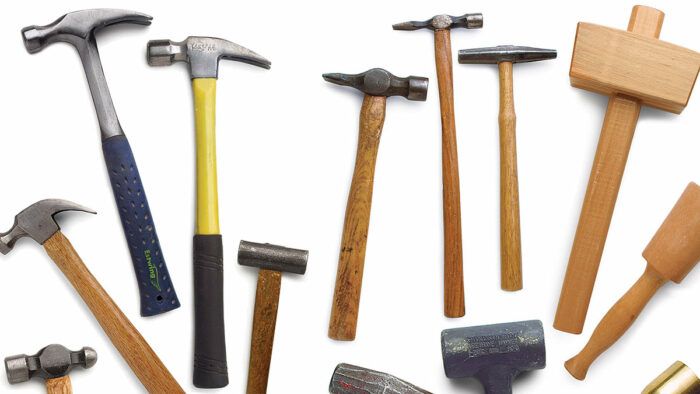Hammers and Mallets
Woodworking's original blunt instrument has evolved into a wide range of specialized hammers and mallets.

Synopsis: Sometimes a little coercion is the most efficient response to a stubborn joint. From a 12-oz. curved-claw hammer to a Japanese hammer to a 2-lb. mason’s lump hammer or a brass-headed mallet, Mario Rodriguez describes the uses of each of his favorite 13 hammers and explains why he likes them best.
Fine woodworking is usually characterized by the careful cutting and fitting of joints that then slide together with only hand pressure. However, sometimes a little coercion is the most efficient response to a stubborn joint. In my shop I employ a variety of hammers and mallets to help me in a multitude of tasks: interior demolition and disassembly of existing work, dryfitting of carcases, built-in installations and adjustment of tools such as the blades on molding planes. My favorite hammers and mallets are laid out here, along with explanations of what I use them for.
16-oz. STRAIGHT-CLAW HAMMER- This hammer is great for heavy work in the shop: assembling large-scale dovetails, driving lag bolts before wrenching them and setting the pronged drive center for a lathe into a blank. The head and handle are one piece, making this hammer a favorite among the pros because of its indestructible nature. At 21 years, this is my oldest hammer.
20-oz. STRAIGHT-CLAW HAMMER- I use this heavy bruiser for construction and installation. The weight and length of this hammer are sufficient to drive an 8d common nail in two blows. The straight claw is useful for chipping stuff out of corners as well as for prying things apart. I prefer a fiberglass handle for a tight and permanent fit with the head; the rubber sheath gives a nonslip grip.
12-oz. CURVED-CLAW HAMMER- For light assembly, this hammer’s compact size reduces the chance of causing inadvertent damage. The red-oak handle feels good, but I have had to tighten it with oak shims a couple of times. The curved claw gives good leverage for pulling out nails without destroying the work.
12-oz. BALL-PEIN HAMMER- A small-scale, machine-shop staple comes in handy in my woodshop. There is always some bit of metal needing to be coaxed into place or straightened out. This hammer also does more mundane duty, such as tamping down paint-can lids.
JAPANESE HAMMER- This hammer is useful for setting the irons in Japanese planes, and for woodworking in tight corners. The head is of cast steel with a handle fitted through the eye and held tightly with wedges.
CROSS-PEIN HAMMERS- Also known as a Warrington hammer, this style is considered a versatile shop hammer, as evidenced by the wide range of sizes it comes in. I use the 31⁄2-oz. hammer for delicate tasks such as nailing brads in picture frames, while the 12-oz. size (left) does universal duty. The tapered pein—the end of the head opposite the main striking head—can be used for starting small nails with less chance of hitting your fingers.
6-OZ. TACK HAMMER- When I picked up this hammer almost 20 years ago at a five-and-dime store, I replaced the original, flimsy lauan handle with a hickory one. Now I love the feel of this tool. It is perfect for restoration work such as setting small, solid-wood patches and inlays. I also use it for setting wedges into joints and for adjusting blades and cutters on my antique planes.
LAMINATED MALLET- The head on this mallet comprises 1⁄16-in.-thick layers of laminated beech, making it stronger, heavier and less prone to splitting than a solid-wood mallet. The face of this mallet is designed to strike the work at a more efficient angle than a square-headed mallet would.
LIGNUM VITAE CARVER’S MALLET- I use this when cutting mortises and carving. Unlike the square mallet, the round shape of this tool allows me to pick it up without having to orient its face to the work. I bought this mallet for $2 because of its crooked handle, but I wouldn’t part with it for $20.
2-LB. MASON’S LUMP HAMMER- I use this brute for light demolition work such as removing interior trim and woodwork. It also provides just the right force for assembling the undercarriage of my Windsor chairs. I replaced the original handle with one made of hickory.
DEADBLOW HAMMER- This rubber mallet features a hollow head filled with lead shot that delivers a solid blow without damaging the work. It doesn’t have much visual or tactile appeal, but it’s good for assembling large carcases.
BRASS-HEADED MALLET- This mallet definitely punches above its weight. I use this compact tool mostly for carving because its ergonomic shape reduces fatigue. An added bonus of its small size is that it takes up less space in a tool bag.
To view the entire article, please click the View PDF button below:
Fine Woodworking Recommended Products

Olfa Knife

Tite-Mark Marking Gauge

Veritas Micro-Adjust Wheel Marking Gauge











Log in or create an account to post a comment.
Sign up Log in